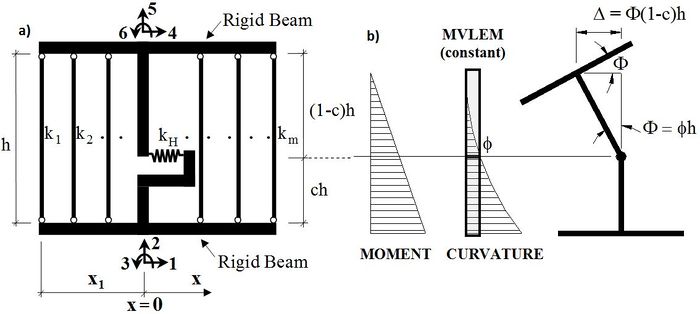User talk:Kkolozvari: Difference between revisions
Kkolozvari (talk | contribs) |
Kkolozvari (talk | contribs) |
||
| Line 15: | Line 15: | ||
Source: /usr/local/cvs/OpenSees/SRC/element/MVLEM/ | Source: /usr/local/cvs/OpenSees/SRC/element/MVLEM/ | ||
[[File:MVLEM.JPG]] | [[File:MVLEM.JPG|700px|thumb|center|Figure 1. a) MVLEM Element, b) MVLEM Rotations and Displacements]] | ||
---- | |||
'''Input Format:''' | |||
{| | |||
| style="background:yellow; color:black; width:800px" | '''element dispBeamColumnInt $eleTag $iNode $jNode $numIntgrPts $secTag $transfTag $cRot <-mass $massDens>''' | |||
|} | |||
{| | |||
| style="width:150px" | '''$eleTag''' || unique element object tag | |||
|- | |||
|'''$iNode $jNode''' || end nodes | |||
|- | |||
| '''$numIntgrPts''' || number of integration points along the element. | |||
|- | |||
| '''$secTag''' || identifier for previously-defined section object | |||
|- | |||
| '''$transfTag''' || identifier for previously-defined coordinate-transformation (CrdTransf) object | |||
|- | |||
| '''$cRot''' || identifier for element center of rotation (or center of curvature distribution). Fraction of the height distance from bottom to the center of rotation (0 to 1) | |||
|- | |||
| '''$massDens''' || element mass density (per unit length), from which a lumped-mass matrix is formed (optional, default=0.0) | |||
|} | |||
Revision as of 20:06, 10 July 2015
Element MVLEM
- Command_Manual
- Tcl Commands
- Modeling_Commands
- model
- uniaxialMaterial
- ndMaterial
- frictionModel
- section
- geometricTransf
- element
- node
- sp commands
- mp commands
- timeSeries
- pattern
- mass
- block commands
- region
- rayleigh
- Analysis Commands
- Output Commands
- Misc Commands
- DataBase Commands
Implemented by:
Kristijan Kolozvari, California State University Fullerton
Kutay Orakcal, Bogazici University, Istanbul
John Wallace, Univeristy of California, Los Angeles
The MVLEM element command is used to generate a two-dimensional Multiple-Vertical-Line-Element-Model (MVLEM; Vulcano et al., 1988; Orakcal et al., 2004) for simulation of flexure-dominated RC wall behavior. A single model element incorporates six global degrees of freedom, three of each located at the center of rigid top and bottom beams, as illustrated in Figure 2a. The axial/flexural response of the MVLEM is simulated by a series of uniaxial elements (or macro-fibers) connected to the rigid beams at the top and bottom (e.g., floor) levels, whereas the shear response is described by a shear spring located at height ch from the bottom of the wall element. Shear and flexural responses of the model element are uncoupled. The relative rotation between top and bottom faces of the wall element occurs about the point located on the central axis of the element at height ch (Figure 2b). Rotations and resulting transverse displacements are calculated based on the wall curvature, derived from section and material properties, corresponding to the bending moment at height ch of each element (Figure 2b). A value of c=0.4 was recommended by Vulcano et al. (1988) based on comparison of the model response with experimental results.
Source: /usr/local/cvs/OpenSees/SRC/element/MVLEM/

Input Format:
| element dispBeamColumnInt $eleTag $iNode $jNode $numIntgrPts $secTag $transfTag $cRot <-mass $massDens> |
| $eleTag | unique element object tag |
| $iNode $jNode | end nodes |
| $numIntgrPts | number of integration points along the element. |
| $secTag | identifier for previously-defined section object |
| $transfTag | identifier for previously-defined coordinate-transformation (CrdTransf) object |
| $cRot | identifier for element center of rotation (or center of curvature distribution). Fraction of the height distance from bottom to the center of rotation (0 to 1) |
| $massDens | element mass density (per unit length), from which a lumped-mass matrix is formed (optional, default=0.0) |